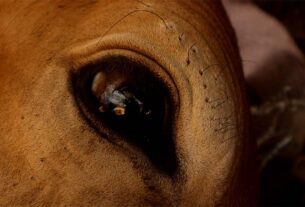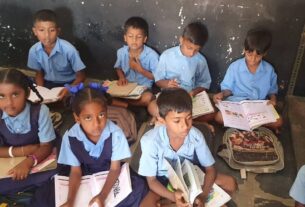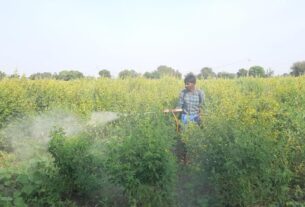Around 600 people in Yallalinga colony in Devadurga taluk struggle for basic needs: water, toilets and shelter.
Anitha, a 15-year-old, walked the uphill concrete road to her home, barefoot, under the scorching sun. She carried two yellow plastic water pots – one on her head and the other on her hip. She was carrying water from a borewell down the road.
People like Anitha, the inhabitants of Yallalinga colony, have to walk everyday to fetch water for their basic needs. They do not have access to clean drinking water, sanitation or housing facilities.
Yallalinga Colony is a notified slum under the Town Municipal Corporation (TMC) of Devadurga, in the district of Raichur, Karnataka. Raichur and Yadgir are the two aspirational districts in Karnataka under the Aspirational Districts Programme (ADP) by the Niti Aayog. ADP aims to “quickly and effectively transform 112 most under-developed districts across the country.”
According to the Karnataka State Human Development Report, 2022, Raichur ranks 28th out of the 30 districts of Karnataka, with a human development index (HDI) of 0.562. The average HDI for the state was 0.644.

Source: Niti Aayog
The report also mentions that Devadurga is one of the taluks with the lowest literacy level in Karnataka. Also, there is a high incidence of malnutrition in the area.
In Devadurga, nestled among rocky hills and dry fields, stand several makeshift huts covered with clothes, sacks and rusty metal sheets.
The inhabitants of the colony, the Sudugadu Siddha community, are originally from Andhra Pradesh, who have been living here for four generations.
Dr. V. Jagadeesh, Associate Professor of Anthropology, Karnatak College, Dharwad, explained in his research paper, A Profile of Sudgadu Siddaru of Dharwad District in Karnataka, that though the name Sudugadu Siddha means those who live in cemeteries and monitor the burning of the dead bodies or bury the bodies, the people never did that. He said that they were nicknamed by the local people to imply that they belong to lower caste and are to be kept separately.
They support themselves by seeking help through alms. They also make and sell brooms, baskets and other household products out of bamboo, cane or palm leaves.
According to Census 2011, there was 29457 Sudugadu Siddha people in Karnataka. In the district of Raichur, it was 1299. They are given Scheduled Caste status in Karnataka.
Maremma, a 60-year-old woman, said, “I have been living here for over thirty years. Most of the people here do not have proper houses, clean drinking water or toilets. I have applied for housing several times, but it has not been accepted yet.”
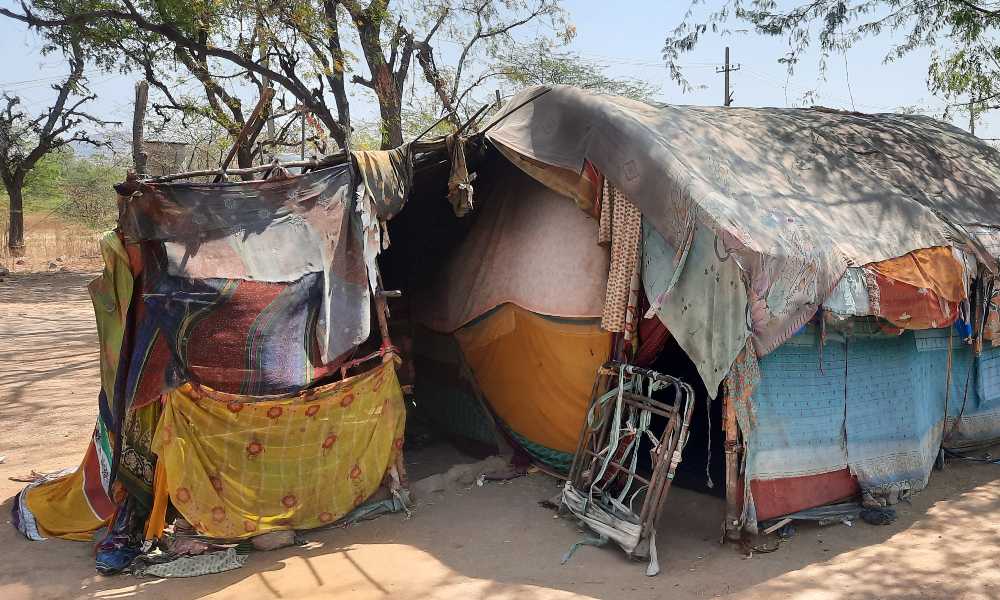
Issaq Ahmed, Junior Programmer at the TMC said, “We receive applications for housing from the people of Yallalinga colony. In 2022-2023, we received about 50 applications. However, we cannot accept those applications as the area is a disputed land.”
In 2001, Akkaraki Yellappa Bangappa, then Devadurga MLA, built 33 houses and gave them to the people. However, an internal dispute arose among the people for land and housing. Currently, the land is under dispute and the TMC officials say that they can provide housing only after the case is resolved.
According to the officials from the Devadurga TMC, Yallalinga colony has a population of over 600 people living in 150 houses. Ahmed said that the colony has around 12 to 15 pucca houses and over 130 temporary sheds. He said, “We don’t have the exact population or data of the people of Yallalinga colony.”
Vikram Bhatt, architect and urban planner, said that the government agencies can prepare a temporary master plan for the area until the land dispute is resolved. He said, “Structures like container housing or bamboo housing could be provided to the people as a short-term solution.”
Apart from housing, the inhabitants of the colony do not have access to clean drinking water or sanitation facilities. They get water from two sources – either from the borewell the TMC has dug or from a water tanker that the TMC sends once in two days or three days or even more than that. Water from the municipality tanker is filled in a cement water tank in the colony from which people collect water for their households.
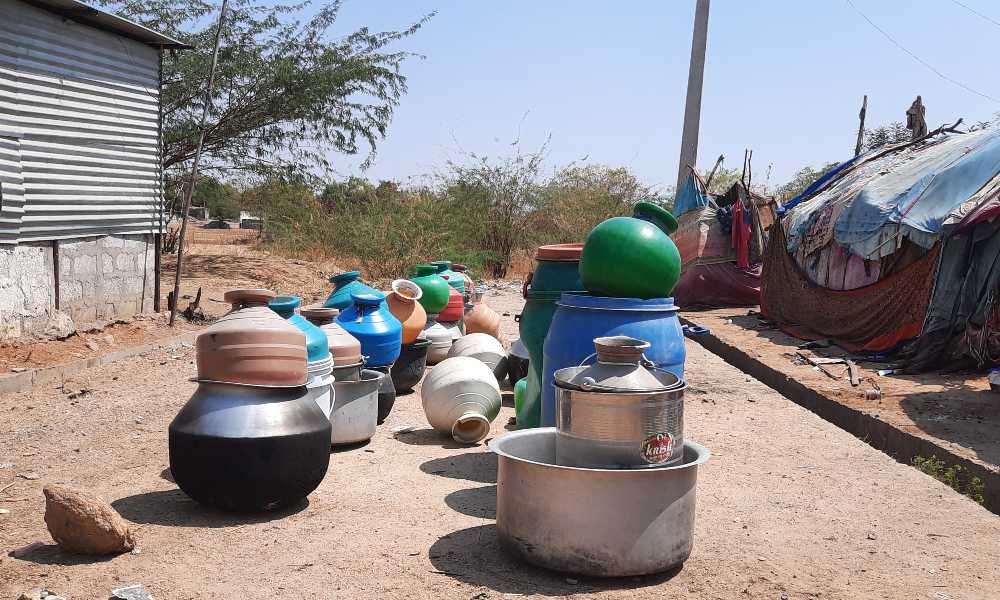
Shivram Pujari, the village community head said, “The Municipality has dug a borewell here. But the water I get from the borewell tap is mixed with dirt. How am I supposed to drink that?” He added that they can’t rely on the tanker, as it is not consistent. He said, “The tanker comes once in three days. Sometimes it comes once in a week.”
However, S. M. Hassan, Junior Engineer at the TMC, said, “It is a false allegation. We sent one water tanker every day.” The tanker is filled with water from river Krishna, he said. He added that the TMC has laid pipes for every household and the people will receive water soon.
Kamala, an inhabitant of the colony and the caretaker of the Shishupalana Kendra there, said that the tanker water is also unfit for consumption. She added, “Comparatively, the borewell water is better. But it is also mixed with mud. If that water is too dirty, we cannot use that as well.” She said, “Sometimes we don’t get enough water. Then we skip taking baths.”
K. Hampaiah, Chief Municipal Officer, said in November 2023, that the TMC will build an overhead water tank with a capacity of five lakh litres for water supply round the clock, within three to four months. However, the work is still incomplete.
Kamala said that the TMC has already started building an overhead tank in the colony a year ago. However, she is not sure if they would get water soon.
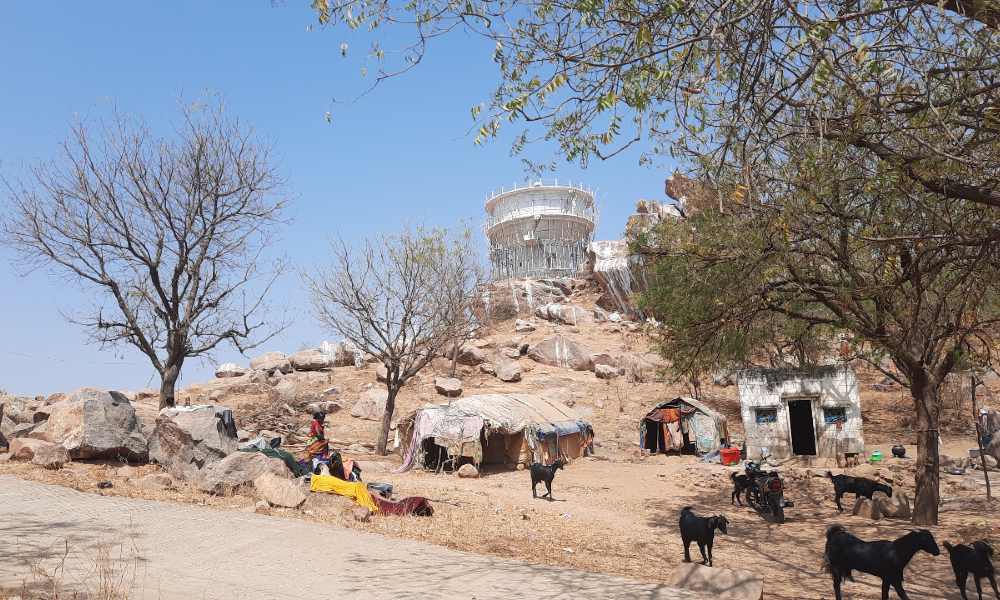
Ahmed, from the TMC, said that the overhead water tank was built by the Rural Drinking Water and Sanitation Department (RDWSD) and the TMC do not know anything about it. However, the Asst. Executive Engineer, RDWSD, Sub Division, Devadurga, said that the TMC is in charge of the water tank.
Rangamma, the anganawadi teacher at Yallalinga colony, said that the people do not get enough water for their daily use. “The tanker water is not sufficient for people. The bore well water is actually unfit for consumption as it is not hygienic. It has a weird smell.”
She added, “Due to lack of water and sanitation, the kids are not hygienic. They bath once every two or three days. They come to the anganwadi without taking a bath.”
According to the United Nations Children’s Fund’s (UNICEF) data on drinking water, sanitation and hygiene, in 2022, 25 percent of the urban population in India did not have access to water supply when needed. The inaccessibility to water supply has increased from the figure in 2015, when 20 percent of the urban population did not have access to water supply when needed.
Kamala added, “We do not have access to toilet facilities in the colony. We have no choice but use the open fields to defecate.” She said that it is difficult for her to go the field leaving her six-month-old baby alone.
“Even if we get a toilet, how can we use it if there is no water?” she asked.She added that the people are ready to give up open defecation if they have access to toilets with proper water supply.
Rangamma said, “People here do not have access to proper drinking water or sanitation facilities. Open defecation is also polluting the existing water resources.”
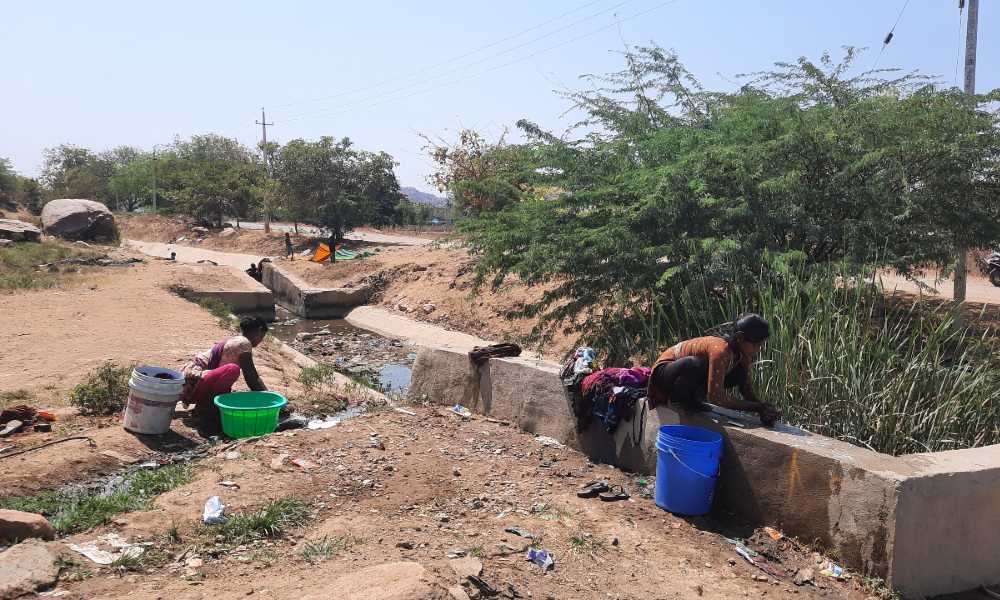
In 2019 it was declared that India is Open Defecation Free (ODF). However, the data from National Family Health Survey (NFHS)-5, published in 2021, contradicts the claim of ODF status. According to the data, 70.2 percent of the households had access to improved sanitation facility but this did not mean access to toilet facilities.
In 2014, Swachh Bharat Mission (SBM) was launched “to achieve an Open Defecation Free (ODF) India by Oct.2, 2019, as a tribute to Mahatma Gandhi.” Under Swachh Bharat Mission -Urban, 34839 community and public toilets (CT and PT) were to be constructed in Karnataka. The target was achieved and 36556 CT and PT were built. In Devadurga TMC, 11 CT and PT were constructed in spite of a target of six.
However, the taluk needs more toilets, as the people of Yallalinga colony, and few other communities in Devadurga practice open defecation due to lack of toilets.
In November, 2023, Devadurga TMC planned to build community toilets in Yallalinga colony under the Swachh Bharat Mission – Urban (SBM-U). However, they dropped the plan due to unavailability of land.
Bhanumathi, Asst. Executive Engineer, SBM Directorate, Bengaluru, said, “Unavailability of land and lack of water supply are the major reasons for toilets not being built.”
Both Kamala and Rangamma said that diseases like diarrhoea, dysentery and vomiting are common in the area, due to lack of access to clean drinking water and sanitation facilities.
According to UNICEF, “Exposed faecal matter contaminates food, water and the environment, and can spread serious diseases, such as cholera.”
Dr. Gangadhar, physician at Taluk General Hospital, Devadurga said that cases of dysentery, gastroenteritis and Hepatitis A are common in the area. He said that the most probable reasons for these diseases are consumption of unclean water and open defecation.
He said that the health department has explained to the people to boil the water before they drink, to make it clean. He added, “That might be a practical problem for them – boiling water every time and waiting for it to cool down.”
He added “Open defecation will definitely contaminate water sources. The pathogens in human excreta will enter human body when people use water contaminated with faecal matter. In rainy season, the contaminated water will be carried away to other water sources, like canals or rivers, increasing the risk of infection. People use this water again. This is a vicious cycle.”
He said that the issue can be solved by educating and making people aware of the importance of drinking clean water and by building latrines for every house.
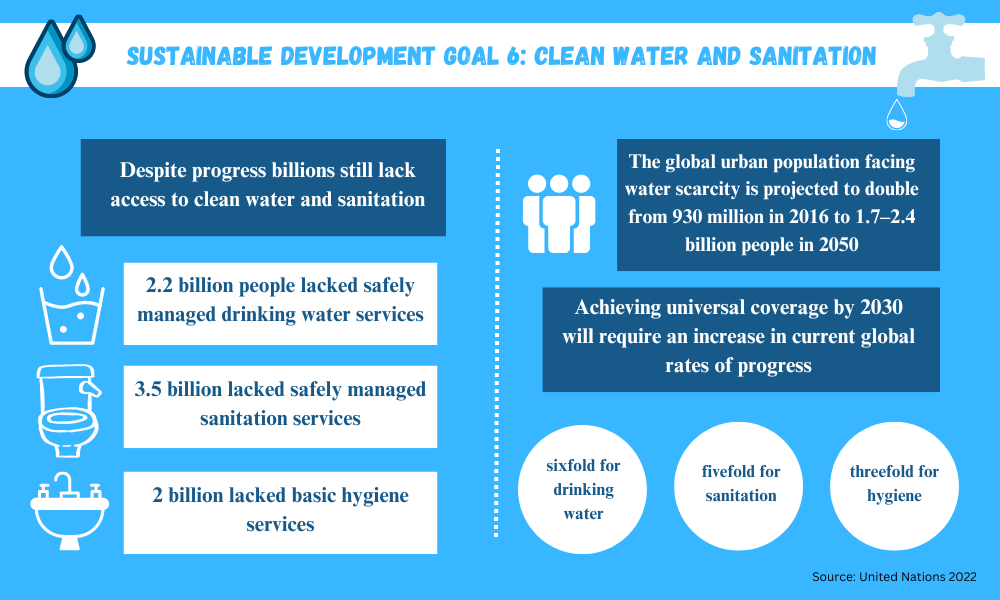
Dr. Nirmala, Ayush Medical Officer at Taluk General Hospital, Devadurga, said that they receive two to three cases of leprosy and tuberculosis from the colony every year. She added that there is a lack of awareness about hygiene among the people.
According to the study, “Poor WASH (Water, Sanitation, and Hygiene) Conditions Are Associated with Leprosy in North Gondar, Ethiopia”, available in the National Library of Medicine, “Access to safe water, sanitation, and hygiene (WASH) is critical for preventing the spread of neglected tropical diseases (NTDs) including leprosy.”
Similarly, according to an article, “How Is TB Transmitted?”available in the National Library of Medicine, sewage contamination of water sources could potentially be a source of Mycobacterium tuberculosis, the causative agent of tuberculosis.
According to the data from Taluk Health Office, Devadurga, in 2023-24, out of the 31 cases of leprosy in the Taluk, two cases were from Yallalinga colony. In 2022-23 and 2021-22, out of 22 and nine cases respectively, one case was from the colony.
In 2023-24, there were five cases of tuberculosis in the colony. In 2022-23, it was two and in 2021-22, there was only one case.
Sheelavalddhyayga Swami, Data Entry Operator at the Taluk Health Office said that they don’t have proper data for water-borne or other gastrointestinal diseases.
He said that such cases are high in summer. He added, “Water-borne diseases are reported as local cases due to reasons like drainage or sewage mixing with drinking water. So, they are not recorded.”
Gowthamghosh. B, Assistant Professor, Institute of Health Management Research (IIHMR) Bangalore, said, “Water is life. But unhygienic water is a leading cause of infectious diseases. Children are more prone to the risk of diseases.”
He added that diseases like tuberculosis and leprosy generally affect people from low-income population. “They live in crammed spaces where they cook and sleep in a same place. This increases the risk of diseases like tuberculosis.”
He said that unsanitary conditions can increase the risk of diseases like cholera and hepatitis. He added that the challenge is not just building toilets but making people use them. He said that it can only be solved through proper awareness.
Anitha continued to walk her way back home. She knew that she should go again tomorrow, to fetch unclean water from the bore well. However, she did not know when she would get clean water through pipes at her home, so that she doesn’t need to walk anymore to get water.


